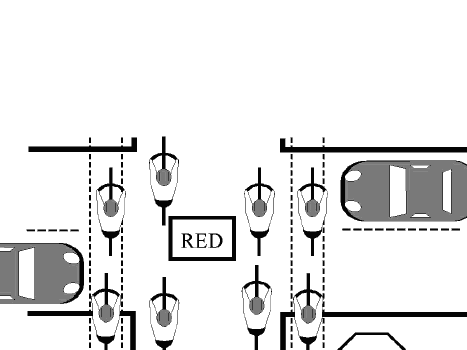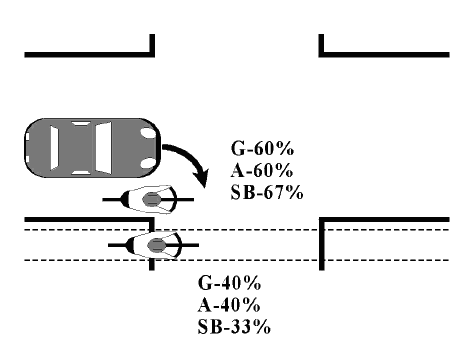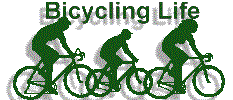Analysis of Bicycle-Motor Vehicle Crashes
Wayne Pein
All police-reported bicycle-motor vehicle crashes occurring in Gainesville, Florida
(158 cases), Austin, Texas (173 cases), and Santa Barbara, California (77 cases) during
the calendar year 1995 were classified according to a slight modification of a typology
developed in the early 1980's by the National Highway Traffic Safety Administration
(NHTSA). NHTSA’s coding scheme, which is based on seminal work in crash analysis by
Cross and Fisher, relies on the police report to identify 45 possible bicycle-motor
vehicle crash types.
A number of variables such as bicyclist age, bicyclist roadway position and direction,
roadway factors, and temporal and environmental attributes were also ascertained from the
police report. These variables are essential to understanding the nature of the crashes so
that appropriate countermeasures can be implemented.
Results.
Table 1 shows in rank order the most prevalent bicycle-motor vehicle collisions in each
city. The listed crashes comprise 85% of all the cases in Gainesville, and 82% of both
Austin and Santa Barbara crashes. Four crash types that are common to all three
communities are color coded to more easily
demonstrate their relative ranking (there are other crash types common to all
three cities but they are not among the top 10 in rank), and reveal similarities and
differences in crash patterns between the cities.
Rank |
Gainesville, Florida |
|
Austin, Texas |
|
Santa Barbara, California |
|
1 |
Drive
Out At Stop Sign
(n=39; 24.7%) |
|
Drive
Out At Stop Sign
(n=27; 15.6%) |
|
Bicyclist
Strikes Parked Vehicle (n=12; 16%) |
|
2 |
Right
Turn On Red
(n=23; 14.6%) |
|
Ride
Out At Intersection
(n=24; 13.9%) |
|
Motorist
Right Turn
(n=12; 16%) |
|
3 |
Drive
Out At Midblock
(n=20; 12.7%) |
|
Ride
Out At Midblock
(n=20; 11.6%) |
|
Drive
Out at Midblock
(n=10; 13%) |
|
4 |
Ride
Out At Intersection
(n=17; 10.8%) |
|
Motorist
Left Turn- Facing Bicyclist (n=15; 8.7%) |
|
Drive
Out At Stop Sign
(n=7; 9%) |
|
5 |
Motorist
Left Turn- Facing Bicyclist (n=11; 7.0%) |
|
Drive
Out At Midblock
(n=12; 6.9%) |
|
Motorist
Overtaking
(n=6; 8%) |
|
6 |
Motorist
Right Turn
(n=10; 6.3%) |
|
Right
Turn On Red
(n=12; 6.9%) |
|
Ride
Out At Intersection
(n=5; 6%) |
|
7 |
Ride
Out At Midblock
(n=8; 5.1%) |
|
Bicyclist
Left Turn In Front
Of Motorist (n=10;
5.8%) |
|
Motorist
Left Turn- Facing Bicyclist (n=4; 5%) |
|
8 |
Drive
Through
(n=7; 4.4%) |
|
Assault
(n=7; 4.0%) |
|
Bicyclist
Lost Control
(n=4; 5%) |
|
9 |
|
Motorist
Left Turn-Bicyclist Same Direction (n=7; 4.0%) |
|
Drive
Out From On-Street Parking (n=3; 4%) |
|
10 |
|
Motorist
Overtaking
(n=7; 4.0%) |
|
Weird
(n=3; 4%) |
|
n=135; 85.4% of 158 total |
|
n=141; 81.5% of 173 total |
|
n=63; 81.8% of 77 total |
|
The 15 different crash types represented in Table 1 are described and listed below in
approximate descending average (among the three communities) rank order of occurrence. The
top five collisions are accompanied by a diagram depicting bicyclist and motorist
positions.
- "Drive Out At Stop Sign." The crash occurred at an
intersection at which the motorist was facing a stop sign. The bicyclist was on a crossing
path.

- "Drive Out At Midblock." The motorist was entering
the roadway from an uncontrolled driveway or alley. The bicyclist was on a crossing path.

- "Ride Out At Intersection." The crash occurred at
an intersection at which the bicyclist was facing a stop sign, red traffic signal, or
failed to yield at an uncontrolled intersection. The motorist was on a crossing path.

- "Motorist Left Turn—Facing Bicyclist." The
motorist made a left turn at an intersection or into a driveway while facing the
approaching bicyclist.

- "Motorist Right Turn." The motorist and bicyclist
were on parallel paths in the same direction, and the motorist was making a right turn at
a roadway intersection or a driveway.

-- note no images for the following, which compose very small percentages of the
accidents reported--
- "Right Turn On Red." The crash occurred at an
intersection at which the motorist was facing a red traffic signal and was attempting a
right turn on red. The bicyclist was on a crossing path (typically coming off the sidewalk
facing traffic).
- "Ride Out At Midblock." The bicyclist was entering
the roadway from an uncontrolled driveway or alley or a shoulder/curb position. The
motorist was on a crossing path.
- "Motorist Overtaking." The motorist was overtaking
the bicyclist. No turning movements were involved. The motorist misjudged the passing
space, stated that the bicyclist was undetected, or the event could not be clearly
specified.
- "Bicyclist Strikes Parked Vehicle." The bicyclist
struck a motor vehicle parked within the roadway right-of-way. The bicyclist may have
struck the driver’s extended side door or the back of the motor vehicle.
- "Bicyclist Left Turn In Front Of Motorist." The
bicyclist made a left turn or swerve in front of an overtaking motor vehicle.
- "Drive Through." The motorist was facing a red
traffic signal and drove over the crosswalk before or after stopping (but not making a
right turn on red), or ran the signal. The bicyclist was on a crossing path.
- "Drive Out From On-Street Parking." The motorist
was exiting (or entering) on-street parking and the bicyclist was riding along the
roadway.
- "Assault." The motorist intentionally struck the
bicyclist.
- "Motorist Left Turn—Bicyclist Same Direction."
The motorist made a left turn at an intersection or into a driveway and the bicyclist was
riding in the same direction (typically facing traffic).
- "Weird." Unusual circumstances.
Discussion.
Comparing cities.
The three most frequent collisions in Gainesville comprising 82 (51.9%) crashes
involve the motorist facing either a traffic control device or merging from a midblock
location and the bicyclist on a crossing path. Of these bicyclists, 65 (79.3%) were riding
on the sidewalk facing traffic. Four bicyclists were riding facing traffic while in the
street. The driver may have failed to yield or failed to stop prior to crossing a stop
line or sidewalk.
The three most frequent collisions in Austin also involve bicyclist and motorist on a
crossing path. Here, however, the second and third ranked collisions, "Ride Out At
Intersection" and "Ride Out At Midblock" are characterized by the bicyclist
violating basic yielding requirements. Moreover, at "Drive Out At Stop Sign"
there were six bicyclists riding facing traffic while in the street, another violation of
traffic law (seven were riding facing traffic on the sidewalk).
Seven "Assault" incidents, the eighth ranking collision in Austin, is
extraordinarily high. Only one "Assault" was noted in Gainesville, and none was
found in Santa Barbara.
In Santa Barbara, the top two collisions have the parties initially on parallel rather
than crossing paths as is the case in Gainesville and Austin. Together, the five most
frequent collisions in Santa Barbara involve primarily driver merging or turning actions.
In some cases bicyclist action/position is a contributing or proximal cause. The number
one crash in Santa Barbara (tied with "Motorist Right Turn"), "Bicyclist
Strikes Parked Vehicle," occurred only once in Austin and did not happen in
Gainesville. All twelve of these events were the bicyclist striking/being struck by an
open(ing) motor vehicle driver door.
Differences in crash patterns between cities are likely in part explained by bicyclist
age differences, sidewalk riding, and size of roads. These three factors are examined
below. The amount of on-street parking on arterial roadways is an obvious variable, and
the extent of community educational efforts also likely plays a significant role.
Age variation. Child bicyclists tend to be involved in different types of
crashes as compared to older bicyclists. Children are more likely to be implicated in
crashes in which they disregarded basic yielding requirements, such as when exiting a
driveway. Figure 6 depicts the age distribution of involved bicyclists in the three
cities.

Bicyclists ages 0-14 comprised 27.1% of victims in Austin, 14.8% in Gainesville, and
10.4% in Santa Barbara. The 0-14 age range accounted for 16 of 20 (80%) "Ride Out At
Midblock" and 12 of 24 (50%) "Ride Out At Intersection" crashes in Austin,
the second and third ranked collisions in that city.
Sidewalk Riding. Bicyclists were riding along the roadway (in contrast to
crossing the roadway at a midblock location or being non-roadway related) in Gainesville
92% of the time, in Austin 88% of the time, and in Santa Barbara 96%. Of these, the
specific location and directional distributions are shown in Figure 7.

Gainesville had substantially more total sidewalk riding among crash involved
bicyclists than the other cities, particularly sidewalk riding facing the normal flow of
traffic. This is at least partial explanation for the appreciable percentage of
"Drive Out At Stop Sign," "Right Turn On Red," and "Drive Out At
Midblock" type crashes, the three most prevalent collisions in this city. These crash
types are more likely to occur as a result of riding on the sidewalk.
Size of road. The collision occurred on a multi-lane road (comprising more than
two lanes) in 72% of the cases in Gainesville, 59% in Austin, and in 47% of the Santa
Barbara crashes. It is possible that bicyclists in Gainesville are more likely to ride on
sidewalks because of the large size and attendant complexity and voluminous motor traffic
of that city’s roads.
Examining the aggregate.
The collisions that occurred in the three cities are characteristic of crash types
found in urbanized areas, where intersections, driveways, sidewalks, and conflicting
movements with motor vehicles are abundant. The top three ranking crashes occur when the
parties are on crossing paths. The fourth, "Motorist Left Turn—Facing
Bicyclist," and fifth, "Motorist Right Turn," ranking crashes involve the
participants on a parallel path and a driver turning movement. Both of these were
over-represented on multi-lane roads. "Motorist Left Turn—Facing Bicyclist"
crashes were over-represented under conditions of darkness, and were especially relevant
to unlighted bicyclists. "Motorist Right Turn" included situations in which the
motorist had overtaken the bicyclist, or the bicyclist was in the process of overtaking
the motorist on the right.
Conclusions/Recommendations
In broad generalities, bicycle crashes in Gainesville are characterized by a large
proportion of sidewalk riding, particularly facing traffic; Austin by a relatively
noteworthy amount of bicyclist violations and driver hostility, with a higher percentage
of young riders; and Santa Barbara by appreciable on-street parking related episodes.
Due to the inherent conflicts at driveways and intersections, bicyclists should ride in
the street and not on the sidewalk. Any riding on the sidewalk should be at a slow speed.
Education and enforcement directed to reducing wrong way and sidewalk riding, is
advisable. Since it is likely that sidewalk riding will be an ongoing issue, and in many
cases tolerated if not encouraged, sidewalk design where bicyclists are expected should
attempt to mitigate the negative consequences of sidewalk riding. Effort should also be
put forth to better ensure motorist compliance with stopping at a stop limit line and
prior to crossing over sidewalks or sidewalk crosswalk areas, whether marked or implied.
It may be advisable to formally mark "implied" crosswalk areas.
Because of their small size, position near the right edge of the road, and relative
infrequency, bicyclists are not as readily noticeable to motorists as are motor vehicles.
Bicyclists should be wary of on-coming motorists turning left in front of them and pulling
out of driveways and side streets. Again, an education/awareness campaign could be
directed at both bicyclists and motorists. At locations where high conflict rates exist,
the sites should be examined taking into account both the motorist and the bicyclist task,
and appropriate countermeasure(s) implemented.
Drivers exiting their vehicles from on-street parking should be more aware of the
presence of bicyclists. This can be addressed through an awareness campaign and/or
"Watch For Bicyclists" signs place with on-street parking. Bicyclists should
learn, again through an education effort, and/or be channelized through pavement markings,
to ride beyond open door range from parked motor vehicles.
The process of crash "typing" with analysis of precipitating actions,
predisposing factors and contributing circumstances is a valuable tool for those
interested in reducing a community’s bicycle-motor vehicle collisions. Different
communities may exhibit varied patterns of crashes. By knowing in what types of crashes
bicyclists are principally involved and under what context, appropriate engineering,
educational, and enforcement countermeasures can be targeted.
Biography.
Wayne Pein formerly was a Research Associate at the University of North Carolina
Highway Safety Research Center. He has been involved in a number of Federal Highway
Administration and state level bicycle and pedestrian research projects.
